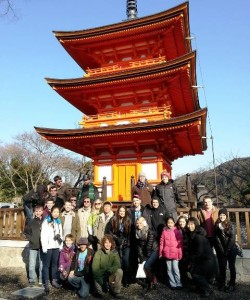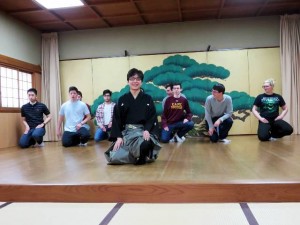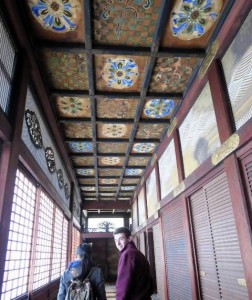By Michele Tallarita ’12
In silence, Hannah Weaver ’14 (Whitefish, Mont.) and several other Lafayette students sat around a long table, upon which bowls, kettles, and napkins had been set with care. Their instructor gestured to show them how to whisk their tea, position their bowls, and communicate with those sitting next to them.
 “There are a lot of things you have to say as you’re drinking from the bowl,” says Weaver, a physics major. “And the main pattern on the bowl has to be facing a certain way.”
“There are a lot of things you have to say as you’re drinking from the bowl,” says Weaver, a physics major. “And the main pattern on the bowl has to be facing a certain way.”
The students received the lesson in the traditional tea ceremony at the Chado Research Center in Kyoto, Japan, as members of the History of Japanese Culture and Government course. Led by Paul Barclay, associate professor of history, and Naoko Ikegami, visiting instructor of Japanese, the class spent two weeks traveling in Japan while learning about the country’s complex and storied history through readings, language study, participation in cultural demonstrations, and classroom lecture and discussion.
The class was one of several faculty-led, short-term study abroad courses offered during the winter break that allow students to experience hands-on study around the world. Now in its 36th year, the program also offered courses in England and Ireland, Hawaii, Kenya, Latvia and Russia, Peru, and South Africa.
Matthew Plishka ’15 (Moosic, Pa.), a double major in history and government & law, had taken a Japanese history course with Barclay and was eager to learn more about the country. The study-abroad students “learned a ton” in two weeks, he said.
 The class toured major temples, shrines, gardens, monuments, and natural vistas of Western Japan, with a concentration on the city of Kyoto. They also participated in demonstrations of Zen meditation, the art of Kimono, ceramics, confectionery making, calligraphy, and fine Japanese cuisine.
The class toured major temples, shrines, gardens, monuments, and natural vistas of Western Japan, with a concentration on the city of Kyoto. They also participated in demonstrations of Zen meditation, the art of Kimono, ceramics, confectionery making, calligraphy, and fine Japanese cuisine.
A highlight for Plishka was his experience with Zen meditation.
“You don’t move. You don’t speak. You don’t lift your eyes off that one spot on the floor,” he says. “It lets you take a step back from the hustle and bustle of everyday life. Some people on the trip said they were going to try to start meditating back home.”
Before visiting a site, the professors gave students questions to ponder and journal about. For example, students might consider the differences between the Shinto practiced at a shrine they just visited to the national Shintoism they had studied in readings. During evening sessions, students discussed their responses. The conversations often challenged them to shift their perspectives.
 “People were making these kinds of broad generalizations about the country after being in it for only a few days,” says Weaver. “Our professors really encouraged us to think about our experience more analytically.”
“People were making these kinds of broad generalizations about the country after being in it for only a few days,” says Weaver. “Our professors really encouraged us to think about our experience more analytically.”
“What we were learning made it a more full experience,” adds Plishka. “If you’re looking at something and you have no context of what you’re looking at, it’s hard to fully appreciate it. But if you understand the time period, why it was built, who built it, it makes it more worth seeing.”
 “There are a lot of things you have to say as you’re drinking from the bowl,” says Weaver, a physics major. “And the main pattern on the bowl has to be facing a certain way.”
“There are a lot of things you have to say as you’re drinking from the bowl,” says Weaver, a physics major. “And the main pattern on the bowl has to be facing a certain way.” The class toured major temples, shrines, gardens, monuments, and natural vistas of Western Japan, with a concentration on the city of Kyoto. They also participated in demonstrations of Zen meditation, the art of Kimono, ceramics, confectionery making, calligraphy, and fine Japanese cuisine.
The class toured major temples, shrines, gardens, monuments, and natural vistas of Western Japan, with a concentration on the city of Kyoto. They also participated in demonstrations of Zen meditation, the art of Kimono, ceramics, confectionery making, calligraphy, and fine Japanese cuisine. “People were making these kinds of broad generalizations about the country after being in it for only a few days,” says Weaver. “Our professors really encouraged us to think about our experience more analytically.”
“People were making these kinds of broad generalizations about the country after being in it for only a few days,” says Weaver. “Our professors really encouraged us to think about our experience more analytically.”